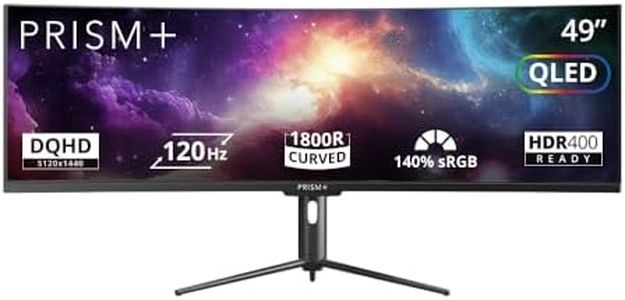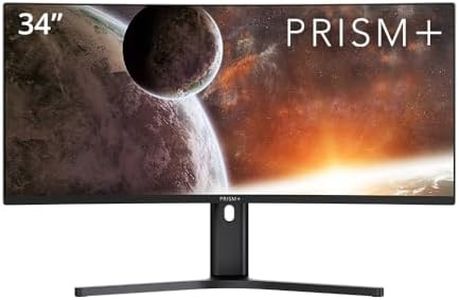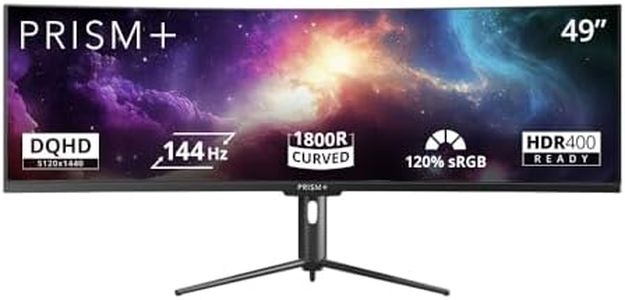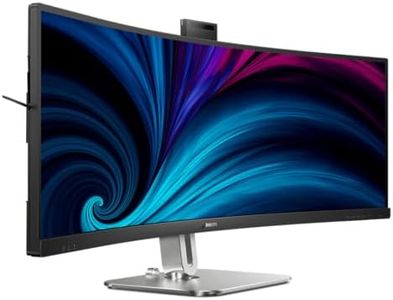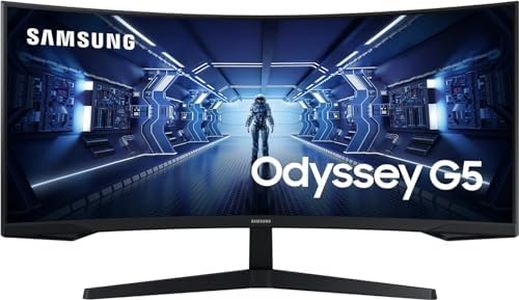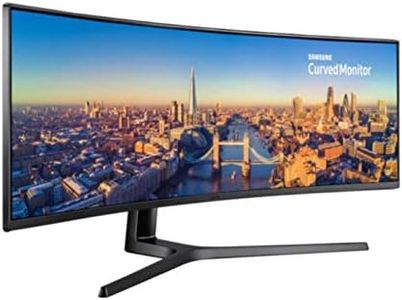We Use CookiesWe use cookies to enhance the security, performance,
functionality and for analytical and promotional activities. By continuing to browse this site you
are agreeing to our privacy policy
8 Best Super Ultrawide Monitor
From leading brands and best sellers available on the web.Buying Guide for the Best Super Ultrawide Monitor
Choosing a super-ultrawide monitor can greatly enhance your work and entertainment experience, thanks to their immersive screen real estate and ability to display multiple windows at once. Before settling on a model, think about how you plan to use it: will it mostly be for productivity, creative tasks, gaming, or watching movies? Understanding your main use cases will help you focus on the monitor features that truly matter for your needs. It’s also helpful to consider your workspace size and computer compatibility. Let’s explore the key specs that differentiate super-ultrawide monitors, so you can make a confident, informed choice.Screen SizeScreen size refers to the diagonal measurement of the display, typically measured in inches. Super-ultrawide monitors usually range from 43 to over 49 inches. Bigger screens offer more horizontal space, which is ideal for multitasking or immersive gaming, but require a large desk and more head-turning as you view content. If you value seeing multiple applications side by side or crave a cinematic gaming experience, a larger size might suit you, whereas a slightly smaller size could be better if your workspace is more limited.
Aspect RatioAspect ratio describes the relationship between the width and height of the screen. Super-ultrawide monitors often have an aspect ratio of 32:9 or even wider. This ratio is much broader than traditional monitors, allowing more content to be displayed horizontally. For tasks like video editing, data analysis, or simulation gaming, a wider aspect ratio can increase productivity or immersion. However, consider whether the extra width matches the software you’ll use, as some programs aren’t optimized for extreme widths.
ResolutionResolution tells you how many pixels are displayed on the monitor, impacting how sharp and detailed everything looks. Common super-ultrawide resolutions include 3840x1080, 3840x1200, and 5120x1440, among others. Higher resolutions provide crisper images, which is helpful if you work with detailed graphics, spreadsheets, or want to watch movies in high clarity. If you mostly browse the web or do simple productivity tasks, very high resolutions might not be as important, but for creative professionals and gamers, aiming higher can be beneficial.
Refresh RateRefresh rate is measured in hertz (Hz) and shows how many times per second the monitor updates with new information. A higher refresh rate, like 120Hz or 144Hz, results in smoother motion, which makes a difference in fast-paced gaming or video editing. For general office or web use, a standard 60Hz refresh rate is often enough, but if you play modern games or value smooth, responsive visuals, look for higher numbers.
CurvatureCurvature refers to how much the monitor’s screen bows towards the viewer. This is usually specified with a number (like 1800R or 1000R), where a lower value means a more pronounced curve. A curved monitor can make wide screens feel more immersive and comfortable, reducing the need to move your head to see screen edges. If you’ll be sitting close and want to feel surrounded by the display, a stronger curve might fit, but for shared viewing or creative work that requires straight lines, a gentler curve or flat monitor could be better.
Panel TypeThe panel type affects color reproduction, viewing angles, and response times. Common types are VA (Vertical Alignment), IPS (In-Plane Switching), and sometimes OLED. VA panels offer good contrast and are typical in ultrawide monitors, while IPS panels provide better color accuracy and wider viewing angles, ideal for photo or video editing. Choose IPS if you work with visuals and need accurate colors; VA if you want deep blacks for movies or gaming; and OLED only if you prioritize top-tier image quality and aren’t concerned with possible burn-in.
ConnectivityConnectivity means the types and numbers of ports available, like HDMI, DisplayPort, USB, and sometimes Thunderbolt. If you plan to connect several devices—like laptops, desktops, or game consoles—make sure the monitor offers the right ports to match your setup. For work, extra USB ports can be handy for charging or connecting accessories directly to the monitor. Think about your existing and future devices when considering this spec.
Ergonomics and Stand AdjustabilityErgonomics covers how much you can adjust the monitor for height, tilt, and swivel. A highly adjustable stand allows you to position the massive screen for comfortable viewing, reducing neck strain and improving your workspace ergonomics. If you’ll be sitting for long periods or sharing the screen with others, look for a stand that lets you tweak the monitor’s position easily.
